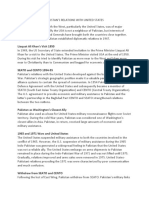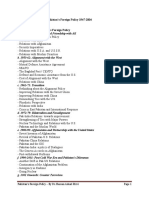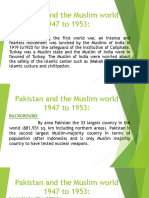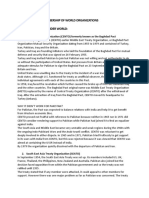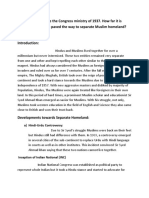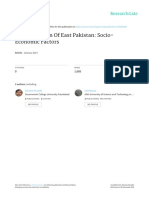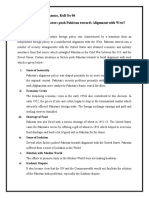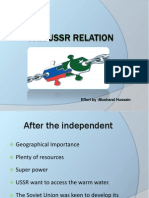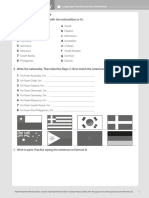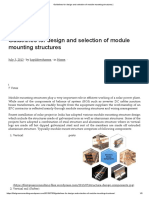Pak Us Relation
Pak Us Relation
Uploaded by
Faeza KhanCopyright:
Available Formats
Pak Us Relation
Pak Us Relation
Uploaded by
Faeza KhanOriginal Title
Copyright
Available Formats
Share this document
Did you find this document useful?
Is this content inappropriate?
Copyright:
Available Formats
Pak Us Relation
Pak Us Relation
Uploaded by
Faeza KhanCopyright:
Available Formats
Timeline of US PAK relations
US PAK relations
United States of America remains one of the first countries to have established diplomatic ties with Pakistan. Although the relationship dates back to October 20, 1947, it can be extrapolated that the relations have been based strictly on military and economic support.
US PAK relations Pre 9/11: 1950-1953
Pakistans first prime minister, Liaquat Ali Khan visited United States to meet president Harry S Truman. It is alleged that during PM Khans first visit to US, president Truman requested Pakistans premier to let the CIA formulate a base in Pakistan, strictly to keep an eye on the activities of Soviet Union
In 1954, Pakistan signed Mutual Defense Assistance Agreement with the United States in May. Establishment of a Military Assistance Advisory Group (Maag) in Rawalpindi. In 1956, President Dwight Eisenhower requested prime minister Suhrawardy to lease Peshawar Air Station to the American Army for keeping an eye on soviet Union and its ballistic missile program.
1960s
During the decade, the pro-American sentiments in Western side of Pakistan were at an all time high. Ayub Khan allowed United States to fly spy mission to Soviet Union from Pakistans territory. United States increased the amount of aid Pakistan was designated to receive from the consortium of Pakistan, half a billion dollars of which were lost in 1965s Indo-Pakistan war.
1971-1974
During 1971s war, US is speculated to have provided Pakistan with arms and military aid, in order to discourage India from penetrating further into the cities of Pakistan. Zulfiqar Ali Bhutto was elected as the president of Pakistan and later on became the prime minister in 1974. Although Bhutto was considered a socialist, he was a close and respected friend of president Nixon, which went in Pakistans favour.
1976-1979:
President Jimmy Carter, an anti-socialist, won the presidential election of US and announced to seek a ban on nuclear weapons. President Carter and his administration allegedly threatened Bhutto to disrupt the process of atomic proliferation and research
1979-1988:
During Zia ul Haqs regime, Pakistan and United States enjoyed a warm and congenial relationship, United States granted billions of dollars to Pakistan in the name of military and economical aid. 1981, Pakistan was discussing a $3.2-billion aid package with United States and in 1987 Pakistan became the second largest recipient of aid after Israel. Congress adopted Pressler amendment
In 1990, US under the Pressler amendment, imposed sanctions on Pakistan, as the country by then had lost its strategic importance in soviet war. In 1992, US and Pakistan relations plummeted further when US ambassador Nicholas Platt, warned Pakistan. 1995, Benazir Bhutto visited United States and requested president Bill Clinton to lift the embargoes on Pakistan and launch a joint operation to eradicate militancy from the region. $368 million of military equipment purchased but not received by Pakistan before the imposition of Pressler amendment sanctions in 1990, was passed; however, the sanctions on arms were not lifted.
In 1998, Prime minister Nawaz Sharif conducted nuclear test in Balochistan, in retaliation to similar tests conducted by India. President Clinton imposed sanctions under Glenn amendment on India as well as Pakistan. Glenn amendment included suspension of aid, including economic development assistance, credits and credit guarantees by the US government, US bank loans to the governments of India and Pakistan, loans from international financial institutions, such as the IMF and World Bank, and exports of dual-use nuclear or missile items. in July of 1998, US lifted the sanctions on both the countries for purchasing agricultural products from US farmers. Later in the year President Clinton exercised his waiver on lifting restrictions on the activities of US banks in Pakistan.
Pak US relations after 9/11
In 2001, after the 9/11 attacks and USs invasion in various countries to eradicate militancy, Pakistan became one of the most important strategic allies for United States. President Pervez Musharraf confessed that the country had no option but to support United States as it had threatened Pakistan of bombing it into stone age if it did not join the fight against al Qaeda. A bill to lift all the sanctions, previously imposed on Pakistan under Pressler and Glenn amendments.
2003, United States officially forgave $1 billion worth of loan it had granted to Pakistan in a goodwill gesture and appreciation for Pakistans cooperation. 2004, President George Bush officially declared Pakistan as a non-Nato ally granting it the authority to purchase strategic and advanced military equipments. Since 2004, US army has launched various drone strikes on the north-western side of the country. Large civilian deaths and caused much opposition from Pakistanis. 2007, A report was issued in which Pakistan was accused of using aid money provided by US to Pakistan for its cooperation on war on terror, for strengthening its defense against India.
In the June of 2008, an air strike by the US Army killed 11 paramilitary soldiers of Pakistan Army Frontier Corps, along with eight Taliban. The strike and deaths instigated a fierce reaction from Pakistani command calling the act to have shaken the foundations of mutual trust and cooperation. 2009, President Musharraf confessed that the billions of dollars of aid that Pakistan received from United States were diverted and channeled in order to build better defense mechanism against India. The famous Kerry-Lugar Bill, which invited much controversy and criticism, was passed in the October of 2009.
In 2010, Pakistan Army in a joint operation with US intelligence agencies captured Mullah Abdul Ghani Baradar, a famous Taliban commander, from the tribal belt of Pakistan. In the beginning of 2011, Raymond Davis, a CIA agent in Pakistan killed two Pakistani men in Lahore, claiming that they came to rob him. In the May of 2011, Osama bin Laden was killed in an operation conducted by US Navy Seals in Abbottabad Pakistani government ordered US army to evacuate Salala air base which was being used to launch offensive on Taliban and militants and also halted Nato supplies for United Sates.
Since the beginning of 2012, various political parties along with the military command of the country, met and held discussions on restoring Nato supplies. On May 18, US lawmakers in the House of Representatives debating the National Defence Authorization Act voted 412-1 for an amendment that could block up to $650 million in proposed payments to Pakistan unless Islamabad lets coalition forces resume shipment of war supplies across its territory. President Zardari arrived in Washington on May 19 to attend the NATO summit in Chicago. However, both the countries were unable to strike a conclusive deal on the restoration of NATO supplies as the summit ended.
Highlights Of the US aid to PAK
US economic assistance to Pakistan peaked in 1962, at over $2.3bn In 2010, military assistance to Pakistan totaled $2.5bn - including $1.2bn in coalition support funds US assistance to Pakistan reached its lowest level in the 1990s, after President George H.W. Bush suspended aid flows over Pakistan's emerging nuclear program. US military assistance dropped dramatically during and immediately after the Indo-Pakistani wars of 1965 and 1971 In the 1970s, President Carter suspended all aid to Pakistan (except food aid) in response to Pakistan's decision to construct a uranium enrichment facility Although US assistance (both economic and military) to Pakistan has fluctuated considerably over the last 60 years, it has risen steadily since 2001. since 1948, the US has sent more than 30bn in direct aid to the country.
Summary of US aid to Pakistan 1948-2010
http://www.guardian.co.uk/global-development/poverty-matters/2011/jul/11/us-aid-to-pakistan
Year Economic Assistance, Total
Economic Assistance (through USAID)
Military Assistance, Total
Coalition Support Funds
Note: All figures are in US$ (millions). Figures are adjusted for inflation and presented in 2009 constant dollars
Source: Wren Elhai, Center for Global Development, 2011
1948 1949
0.77 0
0 0
0 0
1950
1951 1952 1953 1954 1955 1956 1957 1958 1959 1960 1961 1962
0
2.89 74.25 748.29 156.95 733.15 1065.67 1079.65 968.22 1367.93 1689.84 989.53 2334.65
0
0 73.55 286.23 152.24 477.18 700.89 619.9 589.59 985.25 1181.35 780.04 1446.28
0
0 0 0 0 266 1086.5 437.59 533.13 366.81 230.39 260.47 549.02
Year 1963 1964 1965 1966 1967 1968 1969 1970 1971 1972 1973 1974 1975 1976 1977 1978 1979 1980 1981 1982
Economic Assistance, Total 2066.77 2222.66 1928.9 816.28 1213.36 1501.68 541.76 968.32 474.25 692.87 715.35 381.97 614.34 644.1 319.16 214.92 128.81 137.53 164.16 400.6
Economic Assistance (through USAID) 1063.68 1334.16 1041.58 691.28 719.38 672.5 504.31 570.93 31.21 261.87 387.63 219.13 326.02 336.78 209.4 55.49 23.31 0 0 200.07
Military Assistance, Total 292.31 187.55 77.38 8.4 26.33 25.98 0.5 0.87 0.73 0.42 1.24 0.95 0.92 1.28 0.92 1.52 1.2 0 0 1.2
Coalition Support Funds
1983 1984 1985 1986 1987 1988 1989 1990 1991
534.18 568.05 607.26 623.56 599.07 769.14 559.72 548.07 149.59
383.29 415.84 447.53 460.91 469.53 635 421.27 422.37 141.78
499.77 555.9 583.53 545.82 534.54 430.69 367.06 283.44 0
1992
1993 1994 1995 1996
27.14
74.19 68.43 23.13 22.79
0.57
7.98 0 10.1 0
7.2
0 0 0 0
1997
1998 1999 2000 2001
57.17
36.32 102.14 45.72 228.02
0
0 6.72 0 0.54
0
0 0.22 0 0
2002
2003 2004 2005 2006 2007 2008 2009 2010
937.34
377.93 406.12 490.42 689.43 688.62 614.48 1353.65 1867.13
744.74
284.81 316.56 374.04 488.46 498.91 392.05 1076.25 1529.53
1739.7
1760.23 891.39 1397.06 1246.1 1079.72 1378.32 1114.26 2524.61
1386.06
1450.98 794.11 1050.15 916.13 755.74 1014.9 685 1220.5
You might also like
- Foreign Policy of Pakistan in Era of Bilateralism 1962Document1 pageForeign Policy of Pakistan in Era of Bilateralism 1962Malik Sajid0% (1)
- Foreign Policies During Zulfiqar Ali Bhutto EraDocument20 pagesForeign Policies During Zulfiqar Ali Bhutto EraFarooq Shah67% (3)
- Relation With UsaDocument4 pagesRelation With UsaAshraf ali palhNo ratings yet
- Pak US Relations NotesDocument3 pagesPak US Relations NotesAsif KhanNo ratings yet
- Pak-US Relations An Overview 1947-2021Document41 pagesPak-US Relations An Overview 1947-2021Yasmeen AkhtarNo ratings yet
- Foreign Relations of PakistanDocument26 pagesForeign Relations of Pakistansundus_hamid1229No ratings yet
- Pak Us RelationDocument26 pagesPak Us Relationsajid93100% (2)
- Challenges To Pakistan Foriegn PolicyDocument7 pagesChallenges To Pakistan Foriegn PolicyShahzad MIrzaNo ratings yet
- Topic 8 - Pakistan Russia RelationsDocument2 pagesTopic 8 - Pakistan Russia RelationsMahjabeen NaichNo ratings yet
- Pakistan's Relation With Muslim World: IntroductionDocument7 pagesPakistan's Relation With Muslim World: IntroductionHuda FahimNo ratings yet
- Iran-Pakistan RelationsDocument15 pagesIran-Pakistan RelationsMalik Hanif100% (1)
- Kashmir Issue Past Present FutureDocument30 pagesKashmir Issue Past Present FutureThomos ShelbyNo ratings yet
- Pakistan Foreign Policy The Case Study of 911Document13 pagesPakistan Foreign Policy The Case Study of 911Sarina Tareen100% (1)
- Pakistan United States RelationsDocument8 pagesPakistan United States Relationstalhaaftab728No ratings yet
- Pak-Us Relations in 21st Century Challenges and Opportunities For PakistanDocument16 pagesPak-Us Relations in 21st Century Challenges and Opportunities For Pakistank_Dashy8465No ratings yet
- Pak US RelationsDocument3 pagesPak US Relationszia ur rehmanNo ratings yet
- Overview of Pak's Foreign PolicyDocument24 pagesOverview of Pak's Foreign PolicyAli WassanNo ratings yet
- Pakistan and The Muslim WorldDocument12 pagesPakistan and The Muslim WorldSarfaraz KhanNo ratings yet
- Pakistan Foreign PolicyDocument9 pagesPakistan Foreign PolicyIrfan Afghan95% (21)
- Pakistan-Saudi Arabia RelationsDocument7 pagesPakistan-Saudi Arabia RelationsChristopher ServantNo ratings yet
- Pak Studies AssignmentDocument10 pagesPak Studies AssignmentSaffiNo ratings yet
- Pakistan and Muslim WorldDocument25 pagesPakistan and Muslim WorldSyed Muhammad UkashaNo ratings yet
- Pakistan Iran RoundtableDocument17 pagesPakistan Iran RoundtableMushtaq AnjumNo ratings yet
- Pak Iran RelationsDocument2 pagesPak Iran RelationsABDUL RAUFNo ratings yet
- The Benefits and Risks of The China-Pakistan Economic Corridor (CSS Essay) PDFDocument7 pagesThe Benefits and Risks of The China-Pakistan Economic Corridor (CSS Essay) PDFsamairakhan samairakhanNo ratings yet
- Pak-US Relations Under TrumpDocument3 pagesPak-US Relations Under TrumpInstitute of Policy Studies88% (8)
- 01 - India-Afghanistan Relations and Its Implications On PakistanDocument4 pages01 - India-Afghanistan Relations and Its Implications On Pakistanteh089No ratings yet
- Pakistan Relation'S With Iran: Overview of RelationsDocument6 pagesPakistan Relation'S With Iran: Overview of RelationsSamia UsmanNo ratings yet
- Pakistan's Foreign PolicyDocument81 pagesPakistan's Foreign PolicySobiChaudhryNo ratings yet
- Natural Resources of PakistanDocument4 pagesNatural Resources of Pakistanmohsin iqbalNo ratings yet
- Impact of Political Instability On EconomyDocument28 pagesImpact of Political Instability On Economyshahrukh AliyaNo ratings yet
- Pakistan and Changing Regional ApparatusDocument3 pagesPakistan and Changing Regional ApparatusAyan Yousafzai100% (1)
- Pak US RelationsDocument11 pagesPak US RelationsfawadNo ratings yet
- Pakistan and International OrganizationsDocument4 pagesPakistan and International Organizationsfaizakkhan100% (1)
- China Pakistan Economic Corridoor: Prestented by Waleed Babar B-Com Part 2Document9 pagesChina Pakistan Economic Corridoor: Prestented by Waleed Babar B-Com Part 2Sana KhanNo ratings yet
- 27-Ayub KhanDocument3 pages27-Ayub KhanAyan AtifNo ratings yet
- A History of Pak-US RelationsDocument4 pagesA History of Pak-US RelationsFaizan Ahmed SamooNo ratings yet
- Proxy War & Pak Relation With NeighborsDocument25 pagesProxy War & Pak Relation With NeighborsAsif Khan Shinwari100% (3)
- Lec17 Pakistans Role in Regional and International OrganizationsDocument16 pagesLec17 Pakistans Role in Regional and International OrganizationsEhtisham Khan100% (1)
- Gulf Cooperation CouncilDocument13 pagesGulf Cooperation CouncilAnwar KhanNo ratings yet
- Kashmir IssueDocument31 pagesKashmir IssueMaryam Ch100% (1)
- Critically Examine The Congress Ministry of 1937. How Far It Is Correct To Say That It Paved The Way To Separate Muslim Homeland? AnsDocument3 pagesCritically Examine The Congress Ministry of 1937. How Far It Is Correct To Say That It Paved The Way To Separate Muslim Homeland? AnsSajjad AliNo ratings yet
- East Pakistan SeparationDocument8 pagesEast Pakistan SeparationsabaahatNo ratings yet
- What Kinds of Factors Push Pakistan Towards Alignment With WestDocument2 pagesWhat Kinds of Factors Push Pakistan Towards Alignment With Westansha shamasNo ratings yet
- Pak-Russia RelationshipDocument57 pagesPak-Russia RelationshipSamia YounasNo ratings yet
- Western Defense PactsDocument2 pagesWestern Defense PactsNeil Dev100% (1)
- Pak USSR RelationDocument31 pagesPak USSR RelationMusharafmushammad100% (1)
- Economic Cooperation Organization (ECO) - An AnalysisDocument6 pagesEconomic Cooperation Organization (ECO) - An AnalysisSyeda AleenaNo ratings yet
- National Interest of PakistanDocument3 pagesNational Interest of PakistanRamizNo ratings yet
- Democracy in Political Parties in PakistanDocument183 pagesDemocracy in Political Parties in PakistanMuhammad Nawaz Khan Abbasi100% (1)
- Assignment Pakistan-Turkey RelationsDocument9 pagesAssignment Pakistan-Turkey RelationsYousaf AliNo ratings yet
- 9th Lecture, Constitunational and Political Development in Pakistan Since 1947Document11 pages9th Lecture, Constitunational and Political Development in Pakistan Since 1947Daniyal KhanNo ratings yet
- Middle East PDFDocument8 pagesMiddle East PDFFaizan BariNo ratings yet
- Determinants of Pakistans Foreign PolicyDocument9 pagesDeterminants of Pakistans Foreign PolicyPro BoyNo ratings yet
- Afghanistan and The Cold War: PreambleDocument11 pagesAfghanistan and The Cold War: PreambleMazhar HussainNo ratings yet
- Chronological Order Pakistan HistoryDocument13 pagesChronological Order Pakistan HistoryDamon SalvatoreNo ratings yet
- National Integration QuestionDocument6 pagesNational Integration QuestionAsma RasheedNo ratings yet
- Pakistan: In-Between Extremism and PeaceFrom EverandPakistan: In-Between Extremism and PeaceRating: 5 out of 5 stars5/5 (1)
- Barangay Demographic Profile - Cabatuan, Buhi, Camarines SurDocument9 pagesBarangay Demographic Profile - Cabatuan, Buhi, Camarines SurAemann Tanay NuevaNo ratings yet
- LH - Elementary - Teacher's Book Worksheets PDFDocument67 pagesLH - Elementary - Teacher's Book Worksheets PDFNatali Marinovich100% (1)
- Report Project 1Document25 pagesReport Project 1Nurul NadiahNo ratings yet
- Crime Detection and InvestigationDocument14 pagesCrime Detection and Investigationkuya CaRloNo ratings yet
- Pre Requisite: BE 100 Engineering MechanicsDocument3 pagesPre Requisite: BE 100 Engineering MechanicsBalagopal VNo ratings yet
- Split The Rows Into Multiple Worksheets by Rows CountDocument3 pagesSplit The Rows Into Multiple Worksheets by Rows CountAhmed Atef IsmailNo ratings yet
- Abdulfetta 3Document38 pagesAbdulfetta 3Abdufettah JemalNo ratings yet
- Affidavit of Insurance ClaimsDocument2 pagesAffidavit of Insurance Claimsشزغتحزع ىطشفم لشجخبهNo ratings yet
- Ict ReviewerDocument12 pagesIct ReviewerAlex Zénith Abrams100% (1)
- Prospectus PDFDocument19 pagesProspectus PDFAbhishekNo ratings yet
- SD2155 2010 PMDocument2 pagesSD2155 2010 PMmannefrimanNo ratings yet
- DMS MSE Question Bank - 21-22Document3 pagesDMS MSE Question Bank - 21-22Rohan YadavNo ratings yet
- Introduction To The Flora and Fauna of OdishaDocument11 pagesIntroduction To The Flora and Fauna of Odishajitendramakwana350No ratings yet
- Adjectives: Condition Size Apperance Feeling ShapeDocument59 pagesAdjectives: Condition Size Apperance Feeling ShapeEstrellaNo ratings yet
- Safety Data Sheet: Section 1: Identification of The Substance/Mixture and of The Company/UndertakingDocument11 pagesSafety Data Sheet: Section 1: Identification of The Substance/Mixture and of The Company/UndertakingDarshilNo ratings yet
- Qatargas Operating Company Limited: Position: Master/SdpoDocument7 pagesQatargas Operating Company Limited: Position: Master/SdpoEko NatadirdjaNo ratings yet
- Rear (Driven) Bicycle Sprockets. New, Left, Shows No Wear. Right, Used, Shows Obvious Wear From Being Driven ClockwiseDocument7 pagesRear (Driven) Bicycle Sprockets. New, Left, Shows No Wear. Right, Used, Shows Obvious Wear From Being Driven Clockwiseumar_hazrad8219No ratings yet
- Industrial RoboticsDocument45 pagesIndustrial Roboticshimanshu singhNo ratings yet
- Guidelines For Design and Selection of Module Mounting StructuresDocument5 pagesGuidelines For Design and Selection of Module Mounting StructuresRabindra SinghNo ratings yet
- 310-2400/2600 Integrated Zero-Turn Transaxle Service and Repair ManualDocument44 pages310-2400/2600 Integrated Zero-Turn Transaxle Service and Repair ManualJames Isenbart0% (1)
- What Drives Virality (Sharing) of Online Digital Content? The Critical Role of Information, Emotion, and Brand ProminenceDocument20 pagesWhat Drives Virality (Sharing) of Online Digital Content? The Critical Role of Information, Emotion, and Brand ProminenceAurora LuckyNo ratings yet
- LP Math - Comparing DecimalsDocument7 pagesLP Math - Comparing Decimalsapi-422257454No ratings yet
- NITI Aayog: (National Institution For Transforming India), Government of IndiaDocument9 pagesNITI Aayog: (National Institution For Transforming India), Government of IndiasagarNo ratings yet
- Literature Review Vs Book ReviewDocument8 pagesLiterature Review Vs Book Reviewaflruomde100% (1)
- Bujji ResumeDocument2 pagesBujji ResumeAnonymous 2RvlriENo ratings yet
- DLP Tarucsharaleem. Beed 1b Edmath2 1Document7 pagesDLP Tarucsharaleem. Beed 1b Edmath2 1Kyla GarciaNo ratings yet
- P06a CX Abort CodesDocument7 pagesP06a CX Abort CodesasdfNo ratings yet
- Empowerment Technologies-MidtermDocument2 pagesEmpowerment Technologies-MidtermAbraham BojosNo ratings yet
- Project Slide - 2ndDocument18 pagesProject Slide - 2ndFenil JoseNo ratings yet


